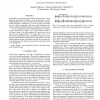Free Online Productivity Tools
i2Speak
i2Symbol
i2OCR
iTex2Img
iWeb2Print
iWeb2Shot
i2Type
iPdf2Split
iPdf2Merge
i2Bopomofo
i2Arabic
i2Style
i2Image
i2PDF
iLatex2Rtf
Sci2ools
ICASSP
2010
IEEE
2010
IEEE
A comparative study of tonal acoustic features for a symbolic level music-to-score alignment
In this paper we review the acoustic features used for music-to-score alignment and study their influence on the performance in a challenging alignment task, where the audio data is polyphonic and may contain percussion. Furthermore, as we aim at using “real world” scores, we follow an approach which does exploit the rhythm information (considered unreliable) and test its robustness to score errors. We use a unified framework to handle different state-of-the-art features, and propose a simple way to exploit either a model of the feature values, or an audio synthesis of a musical score, in an audio-to-score alignment system. We confirm that chroma vectors drawn from representations using a logarithmic frequency scale are the most efficient features, and lead to a good precision, even with a simple alignment strategy. Robustness tests also show that the relative performance of the features do not depend on possible musical score degradations.
Challenging Alignment Task | ICASSP 2010 | Music-to-score Alignment | Musical Score | Signal Processing |
| Added | 06 Dec 2010 |
| Updated | 06 Dec 2010 |
| Type | Conference |
| Year | 2010 |
| Where | ICASSP |
| Authors | Cyril Joder, Slim Essid, Gaël Richard |
Comments (0)

